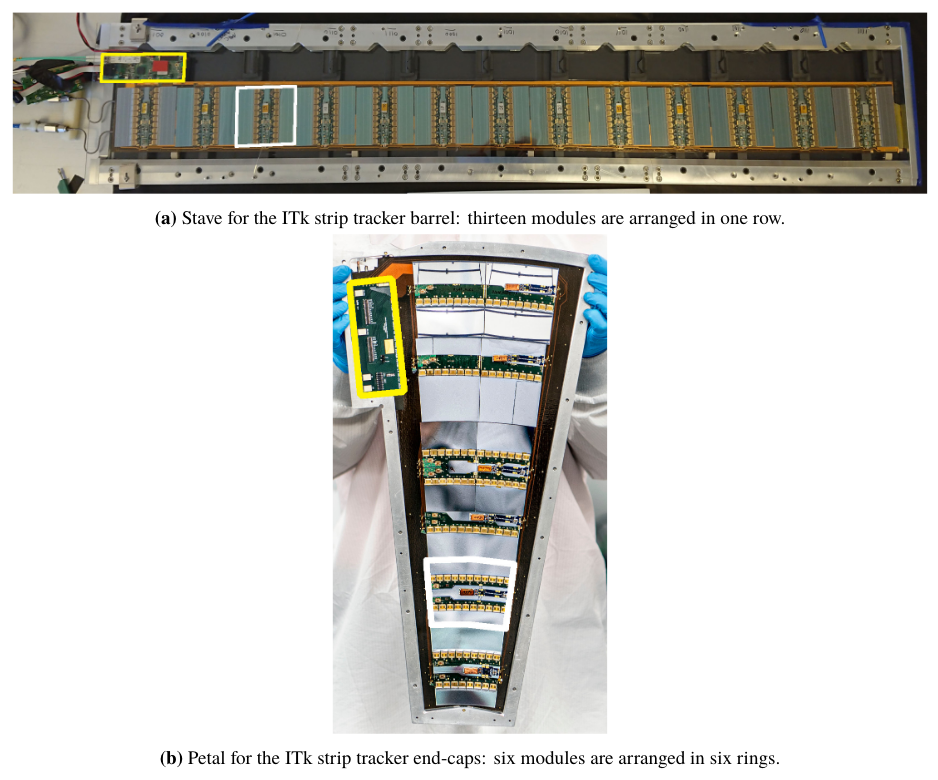Inner Tracker (ITk) Edit Page
Contents
- The ABC130 barrel module prototyping programme for the ATLAS strip tracker
- Technical Design Report for the ATLAS Inner Tracker Strip Detector
The ABC130 barrel module prototyping programme for the ATLAS strip tracker
For the Phase-II Upgrade of the ATLAS Detector, its Inner Detector, consisting of silicon pixel, silicon strip and transition radiation sub-detectors, will be replaced with an all new 100% silicon tracker, composed of a pixel tracker at inner radii and a strip tracker at outer radii. The future ATLAS strip tracker will include 11,000 silicon sensor modules in the central region (barrel) and 7,000 modules in the forward region (end-caps), which are foreseen to be constructed over a period of 3.5 years. The construction of each module consists of a series of assembly and quality control steps, which were engineered to be identical for all production sites. In order to develop the tooling and procedures for assembly and testing of these modules, two series of major prototyping programs were conducted: an early program using readout chips designed using a 250 nm fabrication process (ABCN-250) and a subsequent program using a follow-up chip set made using 130 nm processing (ABC130 and HCC130 chips). This second generation of readout chips was used for an extensive prototyping program that produced around 100 barrel-type modules and contributed significantly to the development of the final module layout. This paper gives an overview of the components used in ABC130 barrel modules, their assembly procedure and findings resulting from their tests.
Further reading: L. Poley, et al., The ABC130 barrel module prototyping programme for the ATLAS strip tracker, 2020 JINST 15 P09004
Technical Design Report for the ATLAS Inner Tracker Strip Detector
This is the first of two Technical Design Report documents that describe the upgrade of the central tracking system for the ATLAS experiment for the operation at the High Luminosity LHC (HL-LHC) starting in the middle of 2026. At this time the LHC will have been upgraded to reach a peak instantaneous luminosity of \(7.5\times 10^{34} cm^{−2}s^{−1}\), which corresponds to approximately 200 inelastic proton-proton collisions per beam crossing. The new Inner Tracker (ITk) will be operational for more than ten years, during which ATLAS aims to accumulate a total data set of 3,000 \(fb^{−1}\). Meeting these requirements presents a unique challenge for the design of an all-silicon tracking system that consists of a pixel detector at small radius close to the beam line and a large-area strip tracking detector surrounding it. This document presents in detail the requirements of the new tracker, its layout and expected performance including the results of several benchmark physics studies at the highest numbers of collisions per beam crossing. The design, construction and expected performance of the large-area silicon-strip tracker are set out in detail. These include the results of measurements of prototype modules and associated support structures and the plans for their mass production. A short description is given of the state of the development of the pixel tracker, which will be presented in detail in the second Technical Design Report document one year from now. This document will also describe the management of the project, its schedule and major milestones. The costs of the new tracker and the collaboration that plans to build it are also presented.
Further reading: ATLAS Collaboration, ATLAS Inner Tracker Strip Detector, ATL-TDR-025, (2017)

